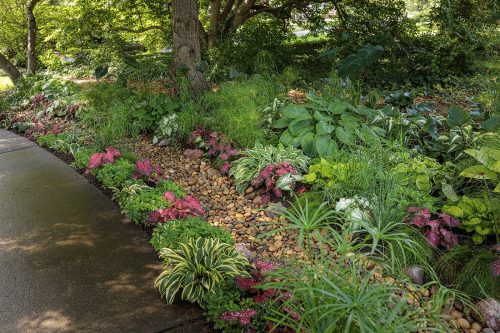
If one of your goals is to garden more sustainably, consider incorporating a DIY rain garden into your landscape. These gardens can look a lot like a perennial garden to help them blend in well with your other garden beds, but they serve a unique ecological purpose.
The primary function of a rain garden is to collect, absorb and filter rainwater and storm runoff to prevent it from flowing directly into your city sewer system. This keeps pollutants like fertilizers, pesticides, pet waste, litter and yard debris out of the wastewater and consequently, prevents them from ending up in streams, rivers and lakes.
Studies by the U.S. Environmental Protection Agency have shown that a substantial amount of pollution in these bodies of water originate in our yards and gardens. Installing a rain garden is a practical, sustainable and beautiful solution to this environmental problem.
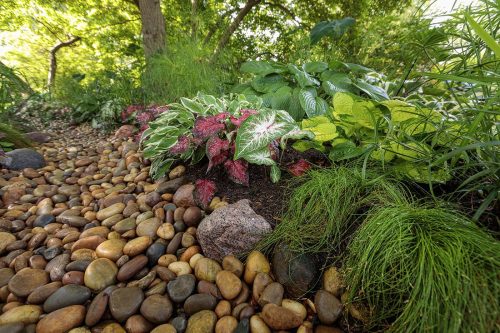
How to Install a DIY Rain Garden
Installing a DIY rain garden is a fairly simple task that doesn’t require much expertise. You’ll need a shovel, a wheelbarrow or tarp, and a strong back to get the job done in a weekend. River rock to line the bottom is optional, but you will need to gather the appropriate plants using the lists below as a guide.
To find an appropriate spot for your rain garden, watch where the water tends to flow off your roof, driveway and other hard surfaces after a heavy rain. Your rain garden should be located where the water runs off, in a slightly sloped or flat part of the yard, at least ten feet away from any buildings. Do not choose a spot where water takes days to soak in after a heavy rain. The point of a rain garden is that you want the water to infiltrate the soil, not pool in it.
Generally, rain gardens are at least twice as long as they are wide and take on an oval, teardrop or kidney shape though most any shape will work. Most range in size from 100 to 300 square feet to accommodate enough of the water that runs off your roof and other hard surfaces.
Remove the grass in the spot you choose for your rain garden and dig a depression that’s no more than one shovelful deep. Aim for a depth of 4 to 8 inches with a flat bottom so the water will soak in evenly throughout your rain garden.
If your rain garden is too deep, it will take too long for the water to infiltrate. At a depth of 4 to 8 inches, it should take less than a week to run dry, thereby avoiding any mosquito breeding issues. As the water soaks in, it will help to replenish the ground water supply.
If you’d prefer your rain garden to look like a small riverbed, you can add river rock to the bottom. Using a layer of landscape fabric between the soil and rocks will help to keep the stones cleaner and prevent them from sinking. But if you plan to plant up the bottom of your rain garden, skip this step.
Planting Your New Rain Garden
You will need a variety of durable plants for your rain garden that can handle both wet and dry soils. When this garden is actively functioning after a storm, the soil will be very soggy. After the rain infiltrates the soil, it will eventually return to being dry until the next heavy rain comes. Choose plants that can handle both extremes, or plan to supplement your rain garden with extra water during drought periods if you use moisture-loving plants.
Generally, the center of your rain garden tends to be the deepest point. That’s where you will plant the varieties that need the extra moisture to really thrive. Closer to the edges and along the top of your rain garden, you can use plants that like a good soaking now and then but can otherwise tolerate drier soils. We’ll show you some of each in the lists below.
RECOMMENDED PLANTS FOR RAIN GARDENS
Grasses
Site anywhere in your rain garden:
Switch Grass (Panicum)
Sedges (Carex)
Shrubs
Site in deepest, moist location:
Winterberry Holly (Ilex verticillata)
Sweetspire (Itea)
Buttonbush (Cephalanthus)
Elderberry (Sambucus)
Red and Yellow Twig Dogwood (Cornus)
Site along the drier sides and top:
Chokeberry (Aronia)
Arrowwood Viburnum (Viburnum dentatum)
Ninebark (Physocarpus)
Smooth Hydrangea (Hydrangea arborescens)
Summersweet (Clethra)
You may notice that many of the recommended plants listed above are North American native species. Plants that have evolved for centuries to thrive without human intervention tend to be tough and versatile—two characteristics rain garden plants require. Such plants also tend to draw in beneficial insects, pollinators and birds, which is a secondary but very important function of this type of garden.
It will be necessary from time to time to clean up your rain garden by clearing away any debris that has found its way in, as well as any sediment that has piled up. By mixing some grasses, sedges and moisture-loving shrubs which have substantial root systems into the garden, you can prevent a good deal of erosion.
Your rain garden will not only be beautiful—it will be functional, too, by mitigating stormwater runoff. Each one of us can do our part to make our gardens more sustainable and keep our environment healthy. Start planning your rain garden today!

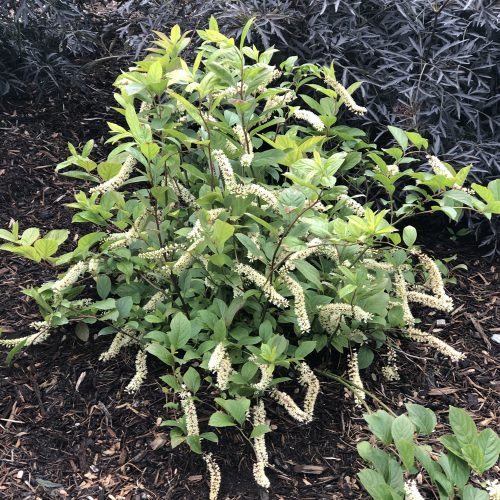
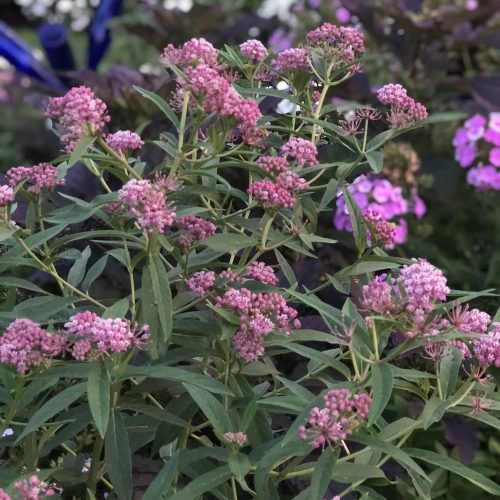
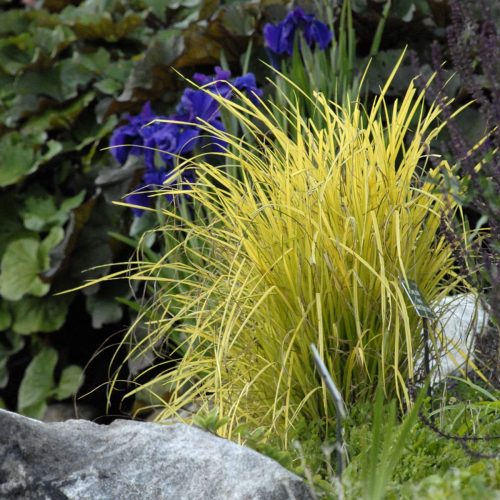
1 thought on “Simple Rain Garden DIY Project”
Very interesting article. I need to think about this!